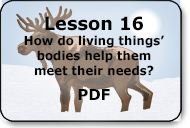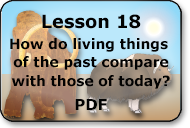How do living things' bodies help them meet their needs? |
In this lesson students will investigate animal adaptations by using different tools to represent different bird beaks.
Download PDF
On successful completion of this lesson, students will be able to: name the four basic needs of all animals; explain how an animal’s adaptations help it meet its basic needs; give one example of an adaptation of a local animal; and sort birds into groups based on their type of beak. |
 |
|
|
| Download PDF |
|
|
|
|
|
Next »
How do living things' behaviors help them meet their needs? |
In this lesson students will learn about behavioral adaptations by playing a game that compares and contrasts different strategies prey animals use to avoid predators.
Download PDF
On successful completion of this lesson, students will be able to: identify examples of animals who migrate, hibernate, or stay active in winter; distinguish between physical adaptations and behavioral adaptatios; and explain two ways prey animals can use behavioral adaptations to avoid predators. |
|
|
|
| Download PDF |
|
|
|
|
|
Next »« Prev
How do living things of the past compare with those of today? |
In this lesson, students will imagine what their area looked like long ago, and learn about the fossilization process through a simulation game.
Download PDF
On successful completion of this lesson, students will be able to: describe one method by which a fossil is formed; give one example of an animal that used to live in Alaska that is now extinct. |
 |
|
|
| Download PDF |
|
|
|
|
|
Next »« Prev
How do people use soil and water resources? |
In this lesson students will learn about sources of drinking water, how water can become polluted, and create their own model of a groundwater aquifer.
Download PDF
On successful completion of this lesson, students will be able to: identify water as a renewable resource; list potential sources of water pollution; and explain why groundwater is used as a source for drinking water. |
|
|
|
| Download PDF |
|
|
|
|
|
Next »« Prev
How do people use energy resources? |
In this lesson students will build simple electric circuits in series with a variety of energy sources, and compare the advantages and disadvantages of each energy source.
Download PDF
On successful completion of this lesson, students will be able to: construct a series electrical circuit; classify renewable and nonrenewable resources that are used to produce electricity; and
identify potential advantages and disadvantages of energy sources. |
|
|
|
| Download PDF |
|
|
|
|
|
Next »« Prev
How can people conserve resources? |
In this lesson students will use an energy monitoring device to investigate which appliances in their school use the most electricity.
Download PDF
On successful completion of this lesson, students will be able to: define conservation; and identify the amount of electricity used by six different appliances; and generate ideas for conserving electricity. |
|
|
|
| Download PDF |
|
|
|
|
|
Next »« Prev
Community Project |
In this culminating project, students use scientific processes and inquiry, along with local knowledge to identify and propose a solution to a local problem.
On successful completion of all units in Theme 3 (Changing Lifestyles), students will be able to answer the following question with detail and specific examples appropriate to their age group: How can my community adapt to a changing landscape?
|
|
|
|
| |
|
|
|
|
|
« Prev
|